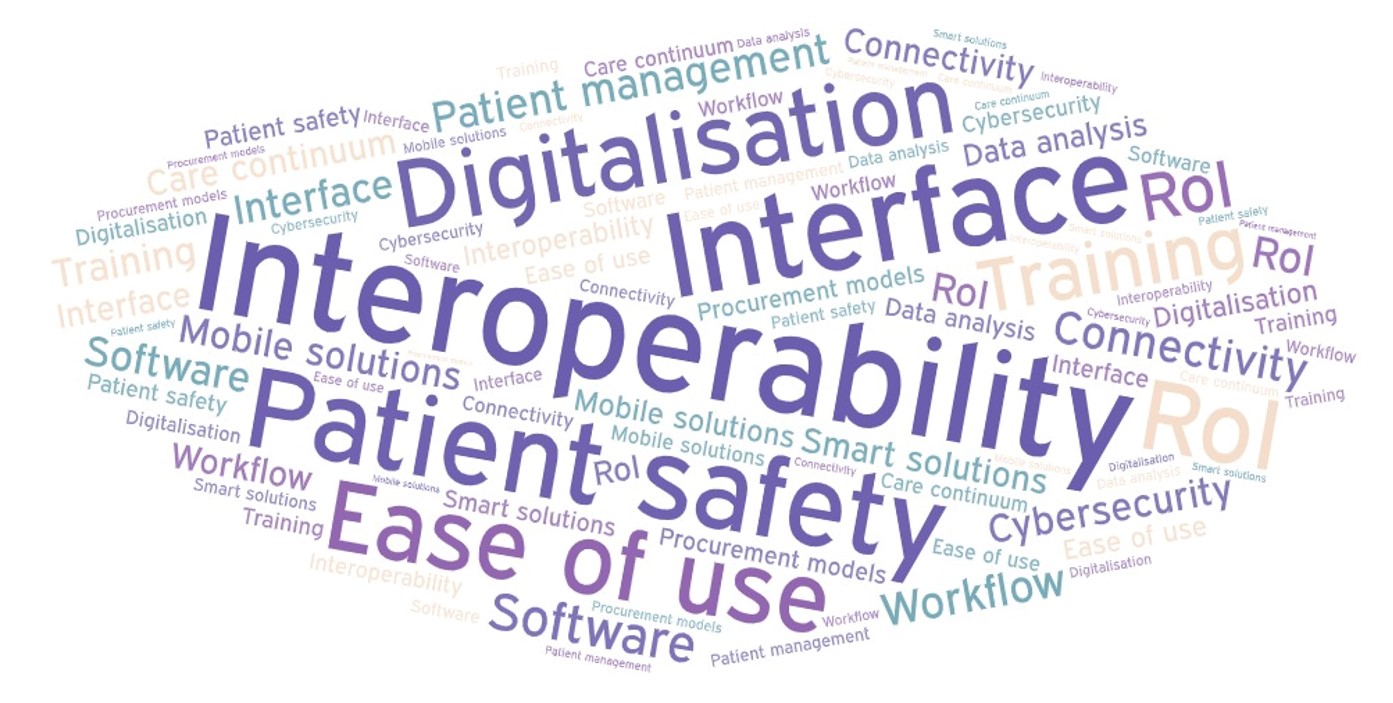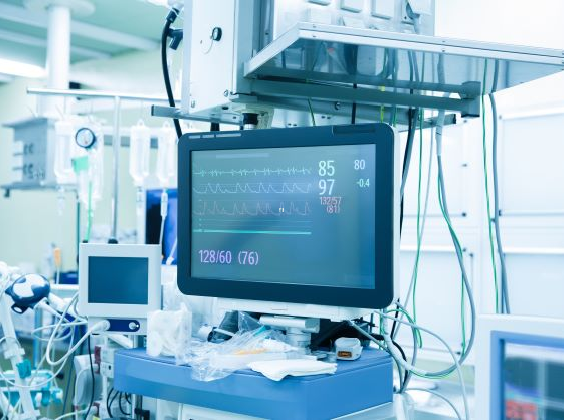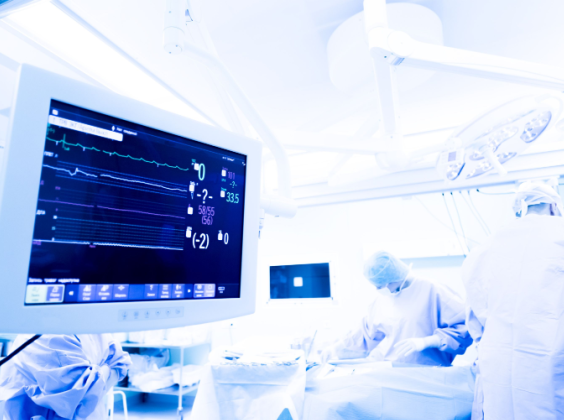
Written by

Cranfield, UK, 9th November 2022 – After two years of digital live streamed events, the 2022 LIVES European Intensive Care Medicine congress (ESICM) returned to an in-person event in Paris, France. In this insight, Signify Research has highlighted some of the key trends discussed with the key exhibiting vendors on the show floor.


Figure 1 – Core topics discussed at ESICM
Trend one: Product developments to help in the care continuum
Both clinical professionals and vendors spoke openly about the importance of addressing the gap between the increasing clinical demands on healthcare provision and the decreasing clinical resource. As such, the topic of moving patients from the ICU to lower-acuity settings to help reduce the burden on healthcare resource is still very resonant. Product innovations demonstrated that vendors are focusing their investments on product flexibility, by enabling solutions to be flexed up or down depending on the patient’s needs, rather than the care setting in which they are in.
GE Healthcare came in with a blast with the launch of their new CARESCAPE Canvas solution, the next play on their CARESCAPE One platform. The Canvas solution is a modular platform that standardises monitoring, addressing frequent issues (such as training, integration, and maintenance) often seen when using multiple solutions across acuity settings. In a similar vein, in the respiratory segment, Hamilton has also rolled out its Adaptive Support Ventilation (ASV) mode throughout its ventilator fleet improving caregiver usability and patient comfort.by adapting to the patient’s needs. With an increasing need for ventilator provision outside of the ICU, the additional feature is promised to improve patient safety no matter the care setting.
With more patients being moved from the ICU much sooner, the need for continuous monitoring throughout the patient pathways is also becoming paramount to reduce ICU readmission due to patient deterioration. As such, there was a new surge in wearable continuous monitoring solutions on display. GE Healthcare once again took centre stage with its grand launch of its new Portrait continuous wearable monitor. Capable of measuring core parameters necessary for in ward monitoring (respiratory rate, SpO2 and pulse rate), GE is pushing forward with their next step in offering flexible wearable patient monitoring. The solution connects into the Edison suite enabling central monitoring of patients within the ward, to help reduce the burden on caregivers. Continuing with the wearable monitoring theme, Masimo’s Radius VSM solution was the highlight on its booth, which also provides continuous patient monitoring of vital parameters (ECG, NIBP, Spo2, and patient positioning), and connects into its Patient Safety Net platform to enable remote access of patient data to ensure patient safety. Mindray was more subdued with its newest offering of a wearable patient monitoring watch which was launched in China two years ago and which will expand to be sold to other countries soon. However, with its comprehensive portfolio of solutions across the clinical settings, the new solution is certainly one to watch out for (excuse the pun) in the coming months.
Trend two: The digital evolution has only just begun
It was very apparent that digitalisation of solutions is of top priority, with a focus on enabling patient data from devices and the EMR to be integrated into other software solutions to enable a comprehensive overview of patient information. Draeger Medical was promoting its upcoming software solution, that has been developed utilising Service-oriented Device Connectivity (SDC) (ISO/IEEE 11-73-SDC). The SDC is a web services-based architecture that enables interoperability amongst medical devices and data exchange between devices, and HL7 compatible clinical and hospital information systems. This enables interoperability between devices and information systems from all vendors to share device data and information bi-directionally and display this information on the core device software and a PC. Draeger claims that this approach will enable the caregiver to make the most of patient data to improve workflow and provide a more comprehensive overview, reducing the need for a separate converter layer required in proprietary systems. The solution is currently being developed to work alongside Draeger’s Infinity M540 monitor. Whilst other vendors have their own IT software solutions to support their devices, this step from Draeger Medical will be seen positively as it reduces interoperability barriers between devices and information systems.
Within the infusion market, Fresenius Kabi and B Braun were also demonstrating their newest connected smart infusion solutions that promise to help improve patient safety and simplify workflow. Fresenius Kabi launched its new Exelia infusion solution whilst at the show, demonstrating its capability to integrate with the Exelia therapy manager to enable centralised pump management. Although not launched at the show, B Braun’s new Spaceplus automated infusion system also demonstrated the movement to toward software-based solutions to improve patient safety, including features such advanced drug libraries with customisable colour coding and automated remote upgrades and updates.
Trend three: Purchasing models will evolve
With software becoming a core focus in all clinical settings, there is a slow and steady transition toward new purchasing models. Software solutions require specific licencing models to enable frequent maintenance to ensure solutions and patient data is secure. As clinical solutions such as patient monitoring become more flexible, with software often at their core, so is the movement toward OPEX based purchasing models. Within the patient monitoring market, the shift from CAPEX to OPEX is also intrinsically linked to a movement from the concept of patient monitoring to the concepts of patient management and ‚Äòmonitoring as a service’. The concept of ‚Äòmonitoring as a service’ has been driven by Philips which has developed an end-to-end monitoring ecosystem, the Enterprise Monitoring as a Service (EMaaS). The solution allows clinicians to follow the patient throughout their entire care journey, from admission to discharge, and their transition across care settings and levels of acuity. Although Philips was not present at the show, other vendors are clearly transitioning toward similar models, especially with their strong push toward more flexible software-based solutions and wearable continuous monitoring solutions.
Trend four: Competition is heating up
Mindray’s broad offering and flexibility to cater to all budget levels didn’t go amiss, with a clear display of its comprehensive portfolio; its ability to offer a complete and connected offering across its clinical device portfolio is helping Mindray to gain traction across all segments. Its M-Connect platform was also showcased, demonstrating its ability to provide a complete connected solution offering.
GE Healthcare was also the talk of the show with its two product launches, showing its eagerness to impress with new solutions that cater toward the growing demands in the monitoring market following the resource crisis seen during the pandemic. This may also be a taster of what is to come with its imminent spin-off allowing for more development opportunities from the company.
Whilst at the show two important announcements were made public that are expected to have a wider impact on the clinical markets. Medtronic announced its intention to spin off its respiratory and patient monitoring business units, enabling Medtronic to focus on its long-term strategy to accelerate innovation-driven growth. With Medtronic being a core vendor in the ventilator and single parameter monitoring segments, this may be seen as an attractive acquisition opportunity for vendors that lack these solutions in their wider offering and want to ensure their competitiveness against those with more comprehensive offerings, such as Mindray and GE Healthcare. Philips also announced that it will be cutting 4,000 jobs in response to its falling revenues and significant losses seen in recent months. It is expected that these cuts are most likely to be within the respiratory and sleep segments, which took a big hit following the recall of a vast number of solutions. ResMed has already been seen to have taken share within the sleep and home respiratory segments whilst the recalls were ongoing. Both developments will pique interest from competing vendors in upcoming months encouraging them to assess the wider impact on their positioning within the market, and if new opportunities will be created for them to take market share.
Trend five: Will live events continue?
The absence of booths from leading vendors such as Philips and Getinge at the event did not go unnoticed, with the latter focusing on interacting with customers in focused voice-of-customer sessions. The pandemic has led to many vendors considering alternative ways to interact and provide more beneficial ways to educate their users on new product innovations and technological advancements. With lower footfall seen by some of those exhibiting, the future of live events and prioritisation of which events to invest in is likely to be more considered moving forward. This development has already been seen at the annual MEDICA congress in Germany, where the exhibitor list has changed significantly over the last decade, with leading vendors deciding not to attend, and investing in exhibiting at product specific events, to ensure their investment is focused on reaching their target customers. With many vendors seeing lower footfall at events, their strategy to reach their target customers may need to evolve also.
About Signify Research
Signify Research is an independent supplier of market intelligence and consultancy to the global healthcare technology industry. Our major coverage areas are Healthcare IT, Medical Imaging and Digital Health. Our clients include technology vendors, healthcare providers and payers, management consultants and investors. Signify Research is headquartered in Cranfield, UK.
More Information
To find out more:
E: enquiries@signifyresearch.net
T: +44 (0) 1234 436 150
www.signifyresearch.net



